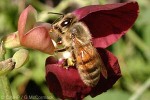Cook Islands Biodiversity Database
Species Page
Apis mellifera
Rango MeriHoney Bee
Multimedia & Additional Resources
| Type | Description | Download |
| Bee opening a legume flower | 49KB | |
| Bee in flight with "pollen sacs" | 60KB |
General Information
Cook Islands Distribution
| Southern Group: Present Makatea: Present | ||||||||
RR |
MG |
AT |
MK |
MT |
AK |
PL |
TK |
MN |
+++ |
+++ |
+++ |
+ |
+ |
+ |
- |
- |
- |
| Northern Group: - | |||||
TN |
MH |
RK |
PK |
NS |
SW |
- |
- |
- |
- |
- |
- |
Scientific Taxonomy
Apis mellifera Linnaeus, 1758
SYNONYMS: Apis mellifera mellifera [Dark European Honeybee]; Apis mellifera ligustica [Italian Honeybee]
TAXONOMY: ANIMALIA; ARTHROPODA; ATELOCERATA; HEXAPODA; INSECTA; PTERYGOTA; Hymenoptera; Apocrita; Aculeata; Apoidea; APIDAE
More Information
SIGNIFICANCE NOTES -. Comment: NBSAP - Aitutaki (1 of 1 wild animals), NBSAP - Mitiaro (7 of 10 wild animals), NBSAP - Atiu (2 of 5 wild)
POSITIVE SIGNIFICANCE: Pollinator
NEGATIVE SIGNIFICANCE: Poisonous sting - serious
GENERAL NOTE: There are 30 subspecies of Apis mellifera: 12 in Africa (where the species originated), 9 in Europe, and 9 in the Middle East.
The first European honeybees introduced to the Americas, Australia, New Zealand and the Pacific were the Dark European Honeybee (Apis mellifera mellifera, originally a native of Western Europe and England. They were introduced to North America around 1621, Australia in 1822 (an 1810 introducing having failed), and New Zealand in 1838 - in each case, from England. A small dark, docile bee adapted to cooler climates with a small over-wintering population enabling it to survive on low nectar flows.
The Italian Honeybee (Apis mellifera ligustica, a subspecies from Italy, was introduced to England in 1859, and from there to Australia in 1862, and other countries - it soon became the most common honeybee. Most are leather coloured, but some are bright yellow and others very pale yellow. Features: docile, not overly inclined to swarm, produce large surplus of honey to maintain a large over-wintering population (needs to be feed in cooler climates).
In the Cook Islands the first honeybees were the Dark European Honeybee and later the Italian Honeybee was introduced. The subspecies often hybridise. The Dark European Honeybee is commonly nesting in the wild on the makatea islands, such as Mangaia. [G.McCormack 2006/3, various sources, especially http://www.bbka.org.uk/articles/honeybee_family.php, and Derek Bettesworth pers. comm.)]
Vouchers & References
Vouchers:
Rarotonga: "honey-bees" listed by William Wyatt Gill in 1876; Italian Bees in hives (Dr Mokotupu), Tupapa, 1980s, G.McCormack. Atiu: Italian Bees in hives (Fr Edwin) and Dark Bees on the makatea, 1980s, G.McCormack.
References:
Special Reference: Kuhlmann, M. (2006) Fauna and Biogeography of the Bees and Wasps of the Cook Islands (Hymenoptera Aculeata), J. Hym. Res. 15(1):26-37.
Data Update History (information):
zTX, zB02, zM02
Web Resources
Citation Information
McCormack, Gerald (2007) Cook Islands Biodiversity Database, Version 2007.2. Cook Islands Natural Heritage Trust, Rarotonga. Online at http://cookislands.bishopmuseum.org. ![]()
Please refer to our use policy.

